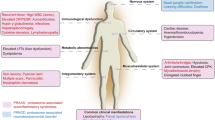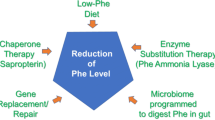Abstract
Summary: We have investigated the correlation between genotype and phenotype in a large number of patients with glutaric aciduria type I (GA I). The deficiency of glutaryl-CoA dehydrogenase has been confirmed in the Rigshospitalet's laboratory in 215 patients since 1975. Most of the patients were of European ancestry. Complete absence of enzyme activity was found in more than half of the patients, while 34% of patients had a residual activity up to 5% and a few patients had a residual activity of 5–15%. In four exceptional cases, a very high residual activity of up to 30% was found. Enzyme studies are thus a reliable method for confirming the diagnosis of GA I, although it may be difficult to distinguish exceptional 'mild' cases from heterozygous carriers for GA I. Three of the patients with very high residual activity are compound heterozygous for the missense mutations R227P and V400M, both of which are associated with residual enzyme activity of 8–10% in homozygous patients. Patients with a mild mutation on at least one chromosome frequently show unusual biochemical findings such as low or normal urinary excretion of glutaric acid and mild or only slightly increased excretion of 3-hydroxyglutaric acid. In contrast, patients with severe mutations such as R402W or A293T on both alleles have no residual activity and show the typical urinary metabolite pattern. Clinical data were available for a subgroup of 79 patients. No correlation with the biochemical phenotype or the genotype could be established.
Similar content being viewed by others
REFERENCES
Biery BJ, Stein DE, Morton DH, Goodman SI (1996)Gene structure and mutations of glutaryl-CoA dehydrogenase:impaired association of enzyme subunits that is due to an A421V substitution causes glu aric acidemia type I in the Amish. Am J Hum Genet 59:1006-1011.
Bjugstad KB, Goodman SI, Freed CR (2000)Age a symptomonse predicts severi y of mo or impairmen and clinical outcome of glutaric acidemia ype I. JPedatr 137:681-686.
Busquets C, Merinero B, Christensen E, et al (2000)Glutaryl-CoA dehydrogenase deficiency in Spain:evidence of two groups of patients,genetically and biochemically distinct.Pediatr Res 48:315-322.
Christensen E (1983)Improved assay of glutaryl-CoA dehydrogenase in cultured cells and liver:application o glu aric aciduria ype I.Clin Chim Acta 129:91-97.
Christensen E, Ribes A, Busquets C, et al (1997)Compound heterozygosity in the glutaryl-CoA dehydrogenase gene with R227P mutation in one allele is associated with no or very low free glutarate excretion. J Inhert Metab Dis 20:383-386.
Goodman SI, Stein DE, Schlesinger S, et al (1998)Glu aryl-CoA dehydrogenase mu ations in glutaric acidemia (type I):review and report of thirty novel mutations. Hum Mutat 12:141-144.
Greenberg CR, Reimer D, Singal R, et al(1995)AG-o-T transversion at the + 5posiionof intron 1 in he glutaryl dehydrogenase gene is associated with he Island Lake variant of glutaric acidemia type I. Hum Mol Genet 4:493-495.
Kölker S, Hoffmann GF, Schor DSM, et al (2003)Glu aryl-CoA dehydrogenase deficiency: region-specific analysis of organic acids and acylcarnitines in post mortem brain predicts vulnerability of the putamen. Neuropediatrics 34:253-260.
Molven A, Matre GE, Duran M, et al (2004)Familial hyperinsulinemic hypoglycemia caused by a defec in he SCHAD enzyme of mitochondrial fatty acid oxidation. Diabetes 53:221-227.
Müshlhausen C, Christensen E, Schwartz M, et al (2003)Severe phenotype despite high residual glutaryl-CoA dehydrogenase activity:a novel mutation in a Turkish patient with glutaric aciduria type I.J Inherit Metab Dis 26:713-714.
Nyhan WL, Zschocke J, Hoffmann G, et al (1999)Glutaryl-CoA dehydrogenase deficiency presenting as 3-hydroxyglutaric aciduria. Mol Genet Metab 66:199-204.
Pineda M, Ribes A, Busquets C, et al (1998)Glutaric aciduria type I with high residual glutaryl-CoA dehydrogenase activity. Dev Med Child Neurol 40:840-842.
Pitt J, Carpenter K, Wilcken B, Boneh A (2002)3-Hydroxyglutarate excretion is increased in ketotic patients:implication for glutaryl-CoA dehydrogenase deficiency testing.J Inhert Metab Dis 25:83-88.
Schwartz M, Christensen E, Superti-Furga A, Brand NJ (1998)The human glu aryl-CoA dehydrogenase gene:report of intronic sequences and of 13 novel mutations causing glutaric aciduria type I.Hum Genet 102:452-458.
Superti-Furga A, Hoffman G (1997)Glutaric aciduria type I (glutaryl-CoA dehydrogenase deficiency):advances and unanswered questions.Eur J Pediatr 156:821-828.
Treacy EP, Lee-Chong A, Roche G, e al (2003)Profound neurological presentation resulting from homozygosity for a mild glutaryl-CoA dehydrogenase mutation with a minimal biochemical phenotype.J Inhert Metab Dis 26:72-74.
Zschocke J, Quak E, Guldberg P, Hoffmann GF (2000)Mutation analysis in glutaric aciduria type I.J Med Genet 37:177-181.
Author information
Authors and Affiliations
Corresponding author
Rights and permissions
About this article
Cite this article
Christensen, E., Ribes, A., Merinero, B. et al. Correlation of genotype and phenotype in glutaryl-CoA dehydrogenase deficiency. J Inherit Metab Dis 27, 861–868 (2004). https://doi.org/10.1023/B:BOLI.0000045770.93429.3c
Issue Date:
DOI: https://doi.org/10.1023/B:BOLI.0000045770.93429.3c




